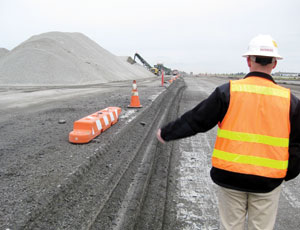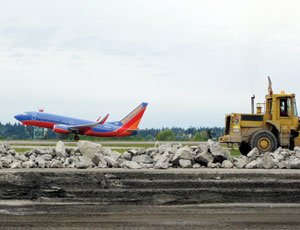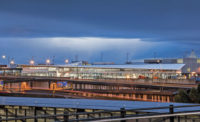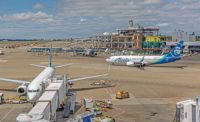...maintain the site during the suspension. Work resumed in July, after the port sold $317 million in revenue bonds.
“We’re back alive and running hard to try to recover lost time,” says Craig Holt, project executive with Turner.


Turner has resumed work on the mat and spread-footing foundation. The company has set four of six 20,000-gallon fuel tanks, measuring 10 ft by 37 ft, in a 17-ft hole on a bed of pea gravel.
“They look like mini submarines,” Holt says. “They are roughly the size of a school bus and will hold enough fuel to fill a typical small car with a 10-gallon tank 2,000 times.”
The project is now tracking for a spring 2012 completion.
The team seeks LEED certification. Sustainability elements include using low-VOC paints, sealants, adhesives and carpets; installing low-flow fixtures; filtering and recycling 85% of the water used to wash vehicles; and treating stormwater to prevent sediment and pollutants from reaching local creeks and killing salmon.
“We have an Olympic-size swimming pool that will house the stormwater before it leaves the site and runs through filters,” Holt says. It will become the floor plate for one of the levels of the parking garage, so no one will ever know it’s there, he adds.
Turner had recycled 97% of construction materials.
Sea-Tac Runway Reconstruction
ICON Materials of Tukwila, Wash., completed a $52-million rehabilitation of Sea-Tac’s first and longest runway (16L/34R at 11,901 ft) at the end of September. Total project cost was $85 million, including taxiways and a new safety light project.
“We’re reconstructing it for the first time since it was built in 1944,” airport spokesperson Cooper says.
Over the years, the airport expanded the runway and repaved with asphalt, but until the third runway was completed in fall 2008 and could handle traffic, the airport could not close the first runway.
Federal Aviation Administration grants and revenue bonds sold in 2005 paid for the project. Port of Seattle engineering staff competed the engineering.
All planes taking off and landing on runways two and three had to cross the construction zone. Crews shut down each one of eight taxiways for 45 days or 50 days, depending on the intersection, completed the work and then reopened that one and closed another. ICON built a temporary taxiway to handle some of the air traffic. A taxiway at the north and south end remained open at all times.
“The most challenging part of the whole project was the interaction with the active airport,” says Bruce Harjehausen, construction division manager for ICON. “We had up to 1,000 planes crossing our project every day.”
Harjehausen says the company met every milestone and beat the deadlines on several of them. He says the company emphasized safety and completed the job with only one recordable injury.
ICON crews ground off, broke up and hauled away about 280,000 tons of asphalt, 2 ft thick from atop the original concrete runway. That work took about 3.5 months.
Crews crushed the 60,000 cu yds of concrete from the original runway and recycled it as gravel for the new runway’s 12-in.-thick subbase. That was topped with 4 in. of asphalt-treated base.
Then ICON began paving a 20-in.-thick Portland cement concrete surface, which can accommodate the largest and heaviest aircraft. The job consumed 120,000 cu yds of new concrete.
The company completed the concrete runway paving and asphalt shoulders by early September.
The port authority expects the new runway will last 40 years. ICON worked two shifts and completed the project in six months.
Sound Transit
Sound Transit also has a project at Sea-Tac, extending the light-rail line from Tukwila Station to the Terminal Station.
Bruce Gray, spokesman for Sound Transit, says agency had planned a terminal station in 2001, but after the Sept. 11 terrorist attacks, the Port of Seattle re-evaluated its plans, forcing Sound Transit to redo its alignment into the airport.
Mowat Construction Co. of Woodinville, Wash., began the $269-million project to extend the guideway and build the station in the fourth quarter of 2006. The project is coming in slightly below budget and on time by the end of the year.
The Port of Seattle built a pedestrian walk bridge from the station to the parking garage, from which passengers can enter the terminal. Trains will run to and from Sea-Tac every six to 10 minutes. The ride to Seattle will take about 33 minutes.



Post a comment to this article
Report Abusive Comment